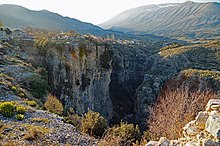Kurvelesh (region)
40°14′12″N 19°52′1″E / 40.23667°N 19.86694°E
| Part of a series on |
| Albanian tribes |
|---|
 |


Kurvelesh is a region in southern
blood feud used to be a common feature of the area.[3] The people of Kurvelesh practised endogamy by intermarrying within the villages of the region.[3]
History
The inhabitants of Kurveleshi revolted against the
Albanian Revolt of 1847 directed against Ottoman Tanzimat
reforms.
Culture
The inhabitants of the Kurvelesh region speak the
gjakmarrja (blood feud) is found in Kurvelesh.[5]
Historical social organization
The mountain region of Kurveleshi was the last example of a tribal system among southern Albanians.[9][10] It was regulated by the Code of Zuli (Kanuni i Papa Zhulit/Zulit or Kanuni i Idriz Sulit).[10] In Kurvelesh the names of the villages were built as collective pluralia, which designated the tribal settlements. For instance, Lazarat can be considered as a toponym that was originated to refer to the descendants of Lazar and Progonat meaning descendants of Progon.[11]
Notable people
- Sali Nivica, politician, writer, journalist and teacher.
- Nafiz Bezhani, jurist, politician and writer.
- Albanian Revolt of 1847.
- Muzafer Korkuti, archaeologist and Vice President of the Academy of Sciences of Albania.
- Jakup Mato, head of Centre of Art Studies of the Academy of Sciences of Albania.
- Hodo Nivica, leader of the Albanian Revolt of 1847.
- Çelo Picari, leader of the Albanian Revolt of 1847.
References
- ^ Geonames. "Kurvelesh region".
- ISBN 9783205994138.
- ^ ISBN 9780198142539. "by the vendetta, which is very strong in the whole of Kurevelesh... For example the Albanians of the Kurvelesh call themselves a group of the Liaps (Liapidhes in the Greek form) and hold their neighbour in contempt. The intermarry only within the villages of the Kurvelesh; they are all Mohammedan, some families are polygamous, and the houses in the mahaladhes are built as fortresses with no windows on the ground floor."; pp. 216-217. "While this journey through Kurvelesh... The villages are Albanian in speech, and it is rare to find a man who knows Greek."
- ^ Giakoumis 2004.
- ^ a b Mangalakova 2004, p. 7.
- ^ Tirta 2004, p. 87.
- ^ Tirta 2004, pp. 149, 72, 73.
- ^ Tirta 2004, p. 308.
- S2CID 163737998.
- ^ a b Mangalakova 2004, pp. 7, 8.
- ^ Desnickaja 1973, p. 48.
Sources
- Desnickaja, A. V. (1973). "Language Interferences and Historical Dialectology". Linguistics. 11 (113): 41–52. S2CID 144569294.
- Giakoumis, K. (2004). "The Ottoman Advance and Consolidation in Epiros and Albania During the Fourteenth and Fifteenth Centuries". Ηπεηρωηηθό Ηκεροιόγηο. 23: 217–244.
- Mangalakova, Tanya (2004). "The Kanun in Present-Day Albania, Kosovo, and Montenegro". International Centre for Minority Studies and Intercultural Relations. Sofia.
- Tirta, Mark (2004). Petrit Bezhani (ed.). Mitologjia ndër shqiptarë (in Albanian). Tirana: Mësonjëtorja. ISBN 99927-938-9-9.
